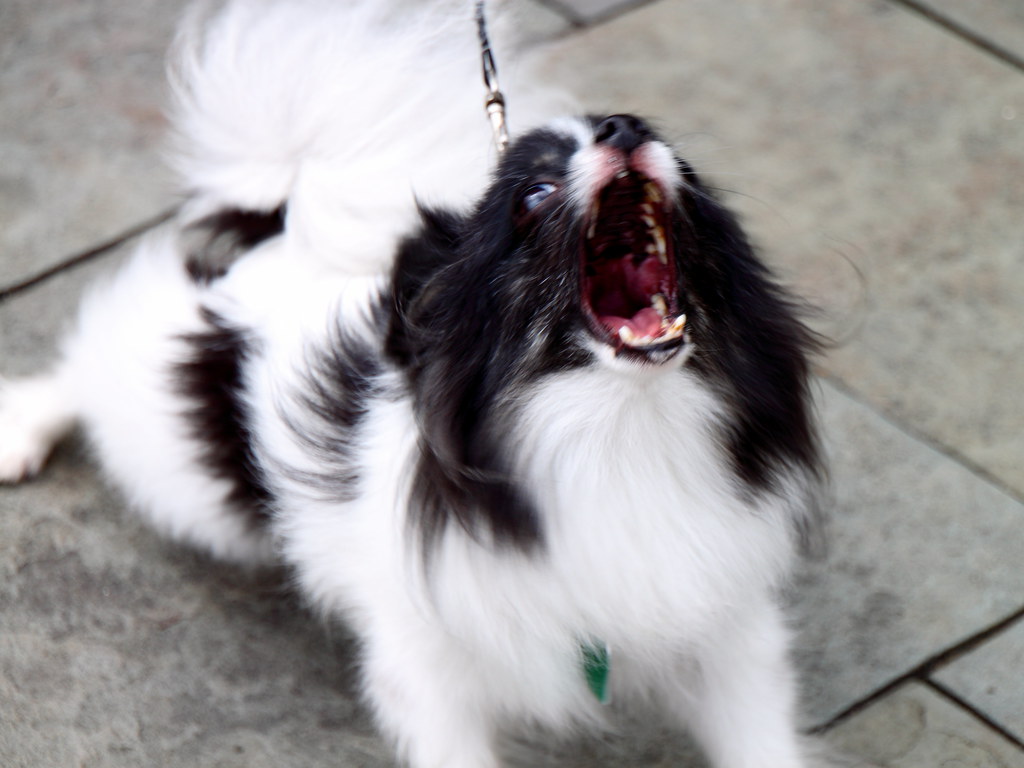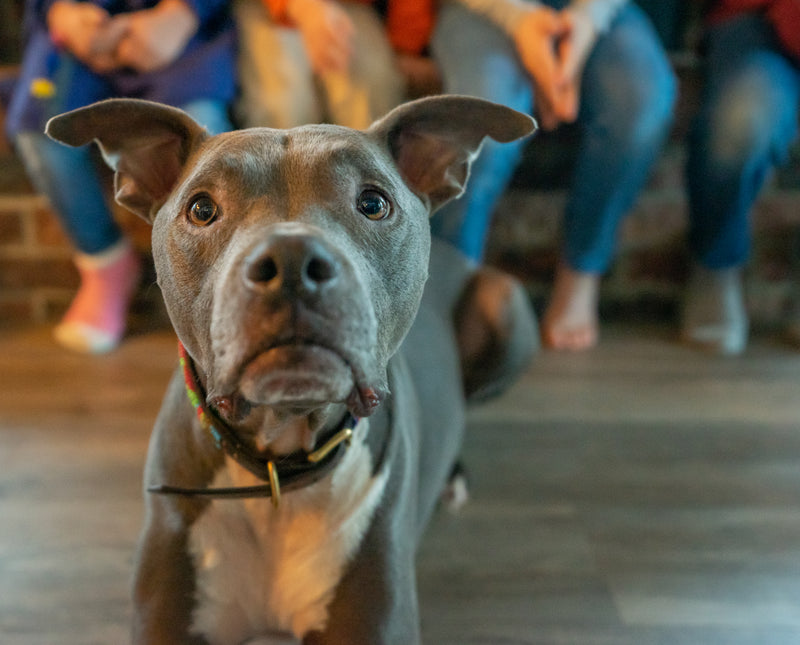Dog ownership can be one of the most fulfilling experiences in life. However, it comes with a daunting responsibility: ensuring your furry friend doesn’t harm others. Aggression and biting are menacing realities that many dog owners face. While it may seem like an insurmountable problem, there are solutions available to tackle this issue head-on. In this blog post, we will explore the causes of aggressive behavior in dogs and provide actionable tips on how to prevent it from happening. So if you’re a dog owner or considering adopting a furry friend, keep reading to learn more about confronting the menacing reality of dog ownership.
Understanding Aggression in Dogs: Causes and Triggers
Aggressive behavior in dogs can be caused by a myriad of factors such as genetics, lack of socialization, fear and anxiety, poor training, pain or illness. It can manifest in different ways from growling and barking to biting. Certain breeds are also prone to aggressive tendencies due to their history of being bred for protection or hunting purposes.
Identifying the triggers that cause aggression is important in managing your dog’s behavior. Some common triggers include fear of strangers or other dogs, territorial instincts and resource guarding (food, toys). Owners should pay attention to signs like raised hackles and bared teeth indicating that their dog is about to become aggressive.
It’s essential for pet owners who suspect that their furry friend has an aggression problem to seek professional help immediately before it becomes a dangerous situation.
Identifying Early Signs of Biting and Aggression in Dogs
Early Signs of Biting and Aggression in Dogs
It’s important to recognize the early signs of aggression in dogs to prevent biting incidents. Growling, snarling, baring teeth, and lunging are all warning signs that your dog may bite. Other signs include raised fur on the back, a stiff body posture, and a fixed stare. If your dog is exhibiting any of these behaviors, it’s crucial to address them immediately.
Dogs may become aggressive due to fear, anxiety, territoriality, or lack of socialization. It’s important to identify the root cause of your dog’s aggression to effectively manage or correct their behavior. Ignoring early warning signs can lead to more severe aggression and potential harm to others.
As a responsible pet owner, it’s your duty to monitor your dog’s behavior and seek professional help if necessary. Don’t wait until it’s too late – take action at the first sign of aggression.
The Importance of Proper Socialization for Your Dog’s Behavior
Proper socialization is an essential component of raising a well-behaved and non-aggressive dog. It involves exposing your furry friend to different experiences, people, and other animals in a controlled environment to help them understand how to react appropriately in various situations. Socialization should begin as early as possible, ideally when the pup is between 3-14 weeks old.
Puppies that lack proper socialization may develop anxiety, fear or aggression towards unfamiliar people or animals. This can lead to biting incidents if not corrected through training techniques such as positive reinforcement and desensitization. Introducing your puppy to new sounds, sights, smells, textures and allowing them positive interactions with other dogs can create a confident adult dog who is less likely to become aggressive.
Socializing your pooch takes time and effort but it’s worth it for both you and your pet’s safety. Remember that every interaction counts – make sure each one ends on a positive note so they continue enjoying the experience.
Training Techniques to Manage or Correct Aggressive Behavior
Positive Reinforcement techniques are among the most effective ways to modify your dog’s unwanted aggressive behavior. This method focuses on rewarding desirable behavior, rather than punishing undesirable ones. It involves offering treats or praise when your dog behaves appropriately, like following commands or playing nicely with other dogs. Conversely, you should ignore problematic behaviors so that you don’t inadvertently reinforce them.
Another technique is counter-conditioning, which aims to replace the negative association underlying aggression with positive ones. For example, if your dog barks at strangers going by outside your window, give him plenty of toys and treats during their appearance and offer distracting activities such as puzzle games if he starts getting agitated.
In training for aggressive dogs always keep in mind that patience is key; results may not be immediate but consistent practice can yield long-term positive changes to a better behaved companion.
What to Do When Your Dog Bites: Steps to Take Immediately After an Attack
If your dog bites someone, it’s important to take immediate action to prevent further harm and protect yourself from legal liability. First, separate your dog from the victim and any other people or animals. Then, assess the severity of the bite and provide first aid if necessary. Contact your veterinarian or a local animal control agency to report the incident and get advice on next steps. Depending on the circumstances, you may need to provide information about your dog’s vaccination history and behavior. It’s also important to cooperate with any investigation or legal proceedings that may follow. Remember that prevention is key: always supervise your dog around people and other animals, and seek professional help if you notice any signs of aggression or biting behavior.
Medical Issues That May Contribute to Aggressive Behavior in Dogs
Medical conditions can sometimes be the underlying cause of aggression in dogs. Pain, discomfort, and hormonal imbalances can all contribute to aggressive behavior. For instance, a dog suffering from an ear infection may become more irritable and prone to biting due to the pain it’s experiencing. Similarly, a dog with an overactive thyroid gland may display aggressive behavior due to hormonal imbalances.
It’s important to take your dog for regular check-ups with a veterinarian to rule out any medical issues that may be causing aggression. If your dog’s aggression is found to be caused by a medical condition, treating the underlying issue can help improve their behavior. In some cases, medication may also be prescribed to manage the aggression while the underlying issue is being addressed.
As a responsible pet owner, it’s crucial to be aware of any changes in your dog’s behavior and seek professional help if necessary. Early intervention can prevent serious incidents and ensure that your furry friend receives the care they need.
Legal Liability for Dog Bite Injuries: Protecting Yourself as a Pet Owner
Dog owners must understand their legal liability for any injuries caused by their pets. In most cases, dog bite laws hold owners responsible for any damage or harm inflicted by their dogs. This includes medical expenses, lost wages, and pain and suffering of the victim(s). It’s essential to have adequate insurance coverage in case of such incidents.
Pet owners must also adhere to local ordinances regarding dangerous breeds. Some states have banned certain types of dog breeds entirely, while others enforce stricter regulations on them. Owners may be required to obtain a special permit or muzzle the dog when in public areas.
In addition to legal responsibility, pet parents should take measures to prevent aggressive behavior in dogs through proper training and socialization from a young age. By doing so, they can minimize the risks associated with owning a dog and help create safer communities for everyone involved.
The Role of Breed-Specific Legislation in Reducing Dangerous Dog Incidents
Breed-Specific Legislation (BSL) has been a controversial topic among dog owners, lawmakers, and animal welfare advocates alike. BSL refers to laws or regulations that target specific breeds deemed “dangerous” based on their history of aggressive incidents. However, experts argue that such measures are ineffective in reducing dog bite incidents as they fail to address the root causes of aggression. Critics also point out that BSL often leads to discrimination against certain breeds regardless of individual temperament or behavior.
Instead of focusing on breed-specific policies, proponents suggest implementing responsible pet ownership laws such as mandatory spaying/neutering, proper socialization and training requirements, leash laws, and holding owners accountable for their dogs’ actions through fines or criminal charges. Investing in education campaigns can also help raise awareness about responsible dog ownership practices and how to prevent bites from happening in the first place.
Ultimately, it is important for communities to find a balanced approach when dealing with dog aggression issues by addressing not only the symptoms but also the underlying factors contributing to them. By promoting responsible pet ownership and ensuring every owner provides appropriate care and attention for their furry companions, we can reduce harmful incidents involving dogs while still upholding the rights of all pets and humans involved.
Supporting Your Canine Companion with Positive Reinforcement Methods
Understanding the Power of Positive Reinforcement in Dog Training
Positive reinforcement is a powerful tool in dog training that involves rewarding desirable behavior with treats, praise, or playtime. This method encourages dogs to repeat good behavior and helps build a strong bond between the owner and pet. By using positive reinforcement, owners can teach their dogs to obey commands, walk on a leash without pulling, and interact appropriately with other animals and people. It is important to note that punishment-based training methods can lead to fear and aggression in dogs. Consistency and patience are key when using positive reinforcement, as it may take time for the dog to learn new behaviors.
Implementing Reward-Based Techniques to Address Aggression and Biting
Positive reinforcement is a powerful tool in addressing aggressive behavior in dogs. This technique involves rewarding good behavior, such as obeying commands or refraining from biting or growling, with treats or praise. By using positive reinforcement methods consistently and generously, pet owners can reinforce desirable behaviors while discouraging negative ones. Key phrases to keep in mind when implementing reward-based techniques are positive reinforcement and consistent training. Remember that aggression is often rooted in fear or anxiety, so be patient and empathetic towards your furry companion as you work together towards a happier and more peaceful coexistence.
Creating a Safe and Positive Environment for Your Canine Companion
It is important to create a safe and positive environment for your dog to prevent aggressive behavior. Provide plenty of exercise, mental stimulation, and socialization opportunities. Establish clear rules and boundaries, and consistently reinforce positive behavior with rewards such as treats, toys, or praise. Avoid using punishment or physical force as it can escalate aggression. Keep your dog on a leash or in a secure area when in public to prevent potential conflicts with other dogs or people. Lastly, seek professional help if you are struggling to manage your dog’s behavior. Consistency and patience are key in supporting your canine companion’s well-being.
The Importance of Consistency and Patience in Positive Reinforcement Training
Consistency and patience are key when using positive reinforcement methods to support your dog’s behavior. It’s important to establish a routine and stick to it, as dogs thrive on predictability and structure. Rewarding good behavior with treats, praise, or playtime can help reinforce positive habits and discourage negative ones. However, it’s important to avoid punishment or physical force, as this can lead to fear and aggression in dogs. Instead, focus on redirecting your dog’s attention and reinforcing desired behaviors consistently over time. With patience and dedication, positive reinforcement training can be a powerful tool for supporting your canine companion’s well-being.
When All Else Fails: Finding Professional Help for Severe Cases of Aggression
Professional Help can be crucial in managing severe cases of dog aggression. It’s important to seek help from a qualified professional, such as a certified dog trainer or animal behaviorist, who has experience working with aggressive dogs. They may recommend techniques such as desensitization and counter-conditioning to change your dog’s response to certain triggers. Medications may also be prescribed in some cases.
It’s important for pet owners to understand that aggression is not something that can always be “fixed” completely, but rather managed through ongoing training and management strategies. Additionally, it’s important to prioritize everyone’s safety – including the dog – and make informed decisions about the best course of action for the situation.
Remember: seeking out professional help early on can mean a safer and happier life for both you and your furry friend!
In conclusion, owning a dog can be a rewarding experience, but it also comes with the responsibility of ensuring that your pet is well-behaved and safe around others. Aggressive behavior and biting are serious issues that should not be taken lightly. By understanding the causes and triggers of aggression in dogs, identifying early signs of biting, providing proper socialization, and using effective training techniques, you can manage or correct aggressive behavior in your furry friend. In case of a dog bite incident, it is important to take immediate action and seek medical attention if necessary. Additionally, being aware of legal liability for dog bite injuries and supporting breed-specific legislation can help reduce dangerous dog incidents. Finally, remember to always support your canine companion with positive reinforcement methods and seek professional help when needed. With proper care and attention, you can enjoy a happy and healthy relationship with your furry friend for years to come.
Questions
Who should be responsible for training a dog?
As a dog owner, you are responsible for training your dog.
What are the best dog breeds for families with children?
Breeds like Golden Retrievers and Labradors are great with kids.
How can I prevent my dog from barking excessively?
Training, exercise, and socialization can help reduce excessive barking.
What should I do if my dog chews on everything?
Provide plenty of chew toys and supervise your dog when possible.
How often should I bathe my dog?
It depends on the breed, but typically once every 3 months is sufficient.
Isn’t it cruel to crate train a dog?
No, when done properly, crate training can provide a safe and comfortable space for your dog.




